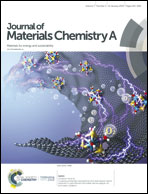In situ nitridated porous nanosheet networked Co3O4–Co4N heteronanostructures supported on hydrophilic carbon cloth for highly efficient electrochemical hydrogen evolution†
Abstract
Three-dimensional Co3O4–Co4N porous nanosheet network (PNSN) heterostructures were controllably prepared on hydrophilic carbon cloth (HCC) through in situ plasma nitridation of cobalt hydroxide, and the Co4N grains were observed to grow epitaxially on Co3O4 with an orientation relationship of Co3O4 (331)//Co4N (111). To achieve effective loading of active materials, we demonstrated a simpler and more eco-friendly approach to ameliorate the hydrophilicity of carbon cloth through hydrogen plasma treatment. The Co3O4–Co4N PNSNs/HCC obtained under optimized conditions showed high catalytic activity and excellent stability for the hydrogen evolution reaction (HER) under basic conditions, e.g., a low overpotential of 90 mV at 10 mA cm−2 and a low Tafel slope of 57.8 mV dec−1. It was revealed that the electron transfer from Co3O4 to Co4N enabled the nanohybrid to have a synergistic effect in terms of the desorption of Had and the release of OH− during the HER, leading to an enhanced intrinsic activity. Moreover, a large number of active sites and a fast charge transport capability of the hybrid system also played beneficial roles in achieving an outstanding HER performance. The in situ plasma nitridation technique provides an alternative approach for developing new nitride-hybridized catalysts based on earth-abundant materials for electrolytic hydrogen production.

- This article is part of the themed collection: 2019 Journal of Materials Chemistry A HOT Papers


 Please wait while we load your content...
Please wait while we load your content...